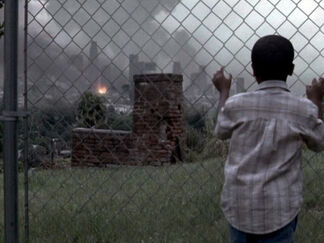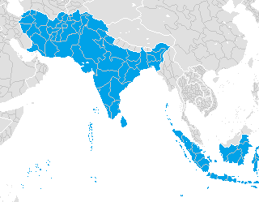The Indian Federation, formerly the Republic of India and sometimes reffered to as the Confederate State of India is the most populus nation on Earth as of 2021 with over 1.5 Billion people.
It is the most populous democracy in the world. Bounded by the Indian Ocean on the south, the Arabian Sea on the south-west, and the Bay of Bengal on the south-east, it shares land borders with the United Saudi Emirates to the west; China and Tibet to the north-east; and Burma to the east. In the Indian Ocean, India is in the vicinity of Sri Lanka; in addition, India's Andaman and Nicobar Islands share a maritime border with Thailand and Indonesia. To the North West it shares a border with Neo-Kzakhstan and the The Neo-Turkmenistan Republic.
the Indian subcontinent was identified with its commercial and cultural wealth for much of its long history. Four world religions- Hinduism, Buddhism,Jainism, and Sikhism originated here, whereas Judaism, Zoroastrianism, Christianity, and Islam arrived in the 1st millennium CE and also helped shape the region's diverse culture. Gradually annexed by and brought under the administration of the British East India Company from the early 18th century and administered directly by the United Kingdom from the mid-19th century, India became an independent nation in 1947 after a struggle for independence that was marked by non-violent resistance led by Mahatma Gandhi.
India is a federal constitutional republic governed under a parliamentary system consisting of 29 states and 7 union territories. India is a pluralistic, multilingual, and a multi-ethnic society. It is also home to a diversity of wildlife in a variety of protected habitats
Politics[]
the Indian Federation is a Federal Parliamentary Constitutional Republic
ANNEXED LAND[]
The Indian Federation has annexed much land in it's existence Including Bangladesh (2018), Most of Iran (2040), Pakistan (2018), Afghanistan (2018), Nepal (2018), Bhutan (2018), Sri Lanka (2040) Indonesia (2040) and Burma (2070)
On the 6th Of February 2049 via referendum Nepal (82%) and Bhutan (96%) voted overwhelmingly to leave the Indian Federation and regain their independent status
Trans Continental Wars[]
Space Program[]
The space program of the Indian Federation has been increasing and expanding. It is now major space power.
Resource Wars[]

An Indonesian Boy watches as the Indian Federation bombs Jakarta
India Went through the Resource Wars mostly untouched by bombs, but it was a major player in the war. It was the nation after The UFEA and Americanadexico that consumed the most oil. It was heavily oil dependant. In response it annexed most of Iran. It then annexed Western Indonesia, Bombing Jakarta and gaining control of the area. The main Island quickly fell to them afterwards.
The Great Emancipation[]
Culture of the Indian Federation[]
The culture of India is the way of life of the people of India. languages, religions, dance, music, architecture, food, and customs differ from place to place within the country. The Indian culture, often labeled as an amalgamation of several cultures, spans across the Indian subcontinent and has been influenced by a history that is several millennia old. Many elements of India's diverse cultures, such as Indian religions, yoga and Indian cuisine
, have had a profound impact across the world.
The Sari
Fashion[]
Traditional clothing in India greatly varies across different parts of the country and is influenced by local culture, geography, climate and rural/urban settings. Popular styles of dress include draped garments such as a sari for women and dhoti or lungi or panche (in Kannada) for men. Stitched clothes are also popular such as churidar or salwar-kameez for women, with dupatta (long scarf) thrown over shoulder completing the outfit. Salwar is often loose fitting, while churidar is a tighter cut. For men, stitched versions include kurta-pyjama and European-style trousers and shirts for men. In urban centres, people can often be seen in jeans, trousers, shirts, suits, kurtas and variety of other fashions. Sari's would prove to be a Fashion trend in the 2120s worldwide.



